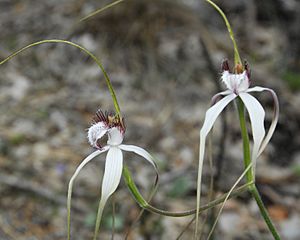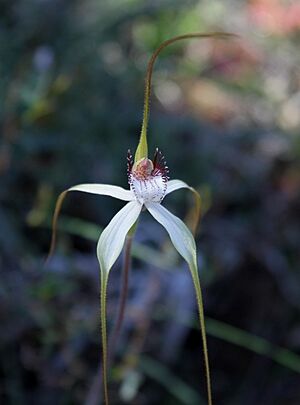Caladenia longicauda facts for kids
Quick facts for kids Caladenia longicauda |
|
|---|---|
 |
|
| Caladenia longicauda in John Forrest National Park | |
| Scientific classification | |
| Genus: |
Caladenia
|
| Species: |
longicauda
|
| Synonyms | |
|
|
Caladenia longicauda is a special type of orchid plant. It belongs to the family called Orchidaceae. This plant is found only in the south-west part of Western Australia. It is also known as the white spider orchid.
You can easily spot this orchid by its large leaf. It also has up to five big, white flowers. These flowers have sepals and petals that hang down. They often have long, thick brown "tails," which is why it's called a spider orchid!
What it Looks Like
Caladenia longicauda is a ground-growing perennial plant. This means it lives for many years and grows from the ground. It is also deciduous, losing its leaves at certain times. It's a herb with a special underground part called a tuber.
Each plant has one hairy leaf. This leaf is about 100–250 mm (4–10 in) long and 5–20 mm (0.2–0.8 in) wide.
Between July and early November, the plant grows a flower stalk. This stalk can be 170–600 mm (7–20 in) tall. It usually has one to three flowers, but sometimes up to five. Each flower is quite large, about 50–180 mm (2–7 in) wide.
The flowers are mostly white. They have some red marks and reddish stripes on the back of their petals and sepals.
- The top sepal, called the dorsal sepal, is green and stands upright. It is 30–140 mm (1–6 in) long and 1.5–6 mm (0.06–0.2 in) wide. Its edges curl slightly inwards.
- The side sepals are 30–150 mm (1–6 in) long and 2–10 mm (0.08–0.4 in) wide. They spread out near their base but then droop downwards.
- The petals are similar to the sepals but a bit shorter and narrower.
The labellum is a special lip-like part of the orchid flower. It is white and measures 7–28 mm (0.3–1 in) long and 6–18 mm (0.2–0.7 in) wide. Along its sides, it has teeth that can be up to 10 mm (0.4 in) long. The teeth in the middle part of the labellum are the longest. They are red with white hooked tips. The front part of the labellum curves downwards, and its teeth get shorter.
There are four to eight rows of small, club-shaped bumps called calli along the center of the labellum. These calli are usually pale to dark red.
After the flower, a fruit grows. This fruit is a dry capsule that opens up (this is called dehiscent). It holds many tiny seeds.

Naming the Plant
The scientific name Caladenia longicauda was first officially described by John Lindley in 1840. This description was published in a book called A Sketch of the Vegetation of the Swan River Colony.
The second part of the name, longicauda, comes from Latin words. Longus means "long," and cauda means "tail." This refers to the long, tail-like parts of the flowers.
There are many different types of Caladenia longicauda, called subspecies. Each subspecies has slight differences in its appearance or where it grows. For example, some have longer labellum teeth, while others grow in specific types of soil or coastal areas. In total, there are 14 known subspecies of this orchid.
Where it Lives
Caladenia longicauda can be found in many different places. It grows in a wide range of habitats across Western Australia. You can find it from the Kalbarri National Park on the west coast all the way to Israelite Bay on the south coast.
Protecting the Plant
Most types of Caladenia longicauda are considered "Not Threatened." This means they are not currently at risk of disappearing.
However, some subspecies need more protection. For example, subspecies extrema and insularis are listed as "Priority One" by the Western Australian Government Department of Parks and Wildlife. This means they are only found in a few places and might be at risk. Subspecies minima is listed as "Priority Two." This means it is not very well known and is also found in only a few locations.
See also
 In Spanish: Caladenia longicauda para niños
In Spanish: Caladenia longicauda para niños

